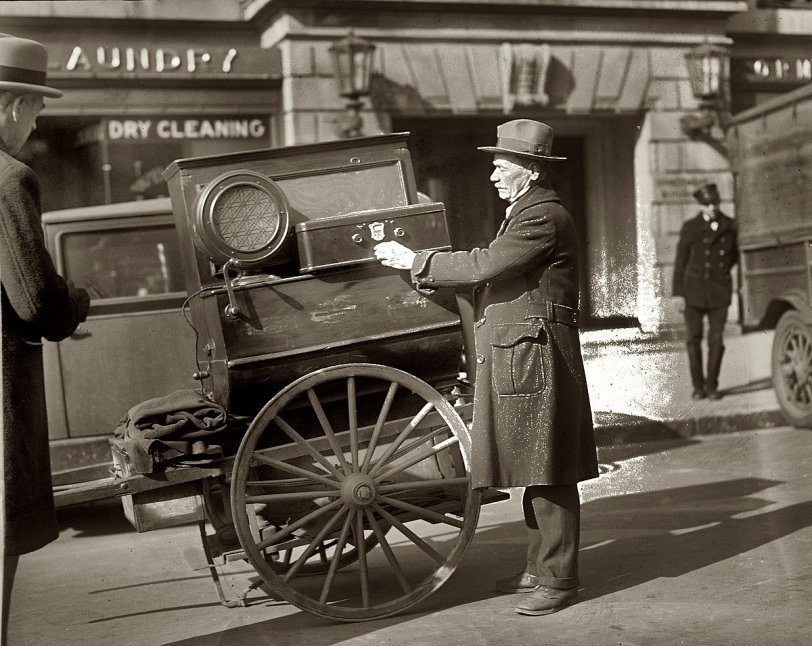


Framed or unframed, desk size to sofa size, printed by us in Arizona and Alabama since 2007. Explore now.
Shorpy is funded by you. Patreon contributors get an ad-free experience.
Learn more.

- Air Quality?
- Sojourner Truth riot
- None were so blind(ed)
- The less famous sister
- Good ol' days?
- Rise and Fall
- Goo Goo Ga Joob
- Ticket Retention
- Not the only one
- Vagaries of War
- Killed by Amtrak
- Back to the Future
- Wanted --
- If you can't stand the light
- Centralized Traffic Control, I believe
- What's really happening
- Heckuva remote control!
- Sometimes — Things Go Bump!
- I SEE THE LIGHT
- Union Switch and Signal Company
- Get That Light Out Of My Eyes
- Eggs. Eggs. Eggs. The Egg Man is Here!
- Foreboding caption
- Famous Hollywood faces
- Not just S&P
- re: Those things in the jar
- Up In Smoke
- Medical Smoking
- Quick fix
- A Quink Comment
Print Emporium
One, Please: 1928

A street vendor and his radio-equipped cart circa 1928 in Washington, D.C. View full size. 4x5 glass negative from the National Photo Company Collection.
That's a barrel piano
The instrument on the cart is a barrel piano. Not truly a hurdy-gurdy. What most people call a hurdy-gurdy is more accurately a street organ or barrel organ or monkey organ (or, in Britain, a busker's organ). Even these are not a true hurdy-gurdy. A hurdy-gurdy is actually a keyed wheel fiddle that is played by the operator, not a programmed barrel, roll, or book, and that dates back to medieval times. The simple fact that both the true hurdy-gurdy and barrel pianos and barrel organs are cranked has led to the blurring of the distinction between these various instruments.
Pitchman
In the depths of the Depression the daily 15 minute Amos and Andy show was afternoon break time. Barbers stopped in the middle of haircuts, bank tellers stopped vending money, and all at the time Amos and Andy came on the radio! For many years, from 1927 or so until 1943 Amos and Andy was the most popular show on the radio.
This little street scene looks a great deal like an old time pitchman, perhaps with his cart loaded with some magic potion guaranteed to fend off everything from cancer to the social diseases, about to turn up the volume and gather a crowd, a "tip" in the pitchman's vernacular.
Thanks to the "vibrator supply, as soon as the 15 minute episode was over the spiel would start.
Atwater Kent
It looks like a battery cable going down to a box just in front of the wheel. If so, the set would probably be a model 67 with matching F7A speaker.
AK-55/60
That radio looks very familiar, as I personally own an Atwarer Kent 60. The 55 and 60 were identical, except the 60 has an additional tuning stage for fringe reception. These models were introduced in 1929, and continued into 1930 and 31. By the knobs it appears to be a later version, so I would guess the photo was taken around 1930.
One more note: the standard 55 and 60 models were AC sets, but there were indeed variations available that used batteries. This may have indeed been one of the variations.
AK Radio
It could be a "battery" model 67 with matching F7A speaker.
Hurdy Gurdy Man
It appears from the crank that this is a hurdy gurdy man who has updated his presentation with a battery powered radio. He was clearly a very with it gent. As Brent points out, batteries were the most common way and perhaps the only way to power a radio in 1925. But where is the antenna?
On another subject, this negative has suffered some decay. Can anyone identify the cause of the efflorescence?
[Looks like mold. - Dave]
Radio by the minute?
So what was that guy vending? Radio by the minute?
If it wasn't a tube radio how did it drive that large speaker?
Radio ID
I don't mean to contradict you Earl but if the date of the photo is 1925 then it can't be the Atwater Kent 55 or 60 since as far as I can tell neither was manufactured in 1925. The 1925 date makes it extremely likely that it was a battery operated radio from whatever company since Ted Rogers Sr. didn't invent the first AC radio tube until 1925 and presumable they were pretty expensive in that first year of manufacture.
[The caption says circa 1925. Circa means approximately. It's a guess. It could easily be a few years after that. - Dave]
Atwater Kent Radio
This is an Atwater Kent model 55 or 60 Radio. These were AC powered sets, so where is the power coming from? These sets sold for about $100 without tubes. The speaker sold for about $34. They were quite popular and modern for their time (1929).
























On Shorpy:
Today’s Top 5